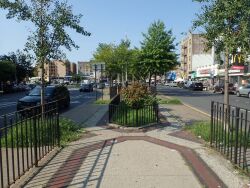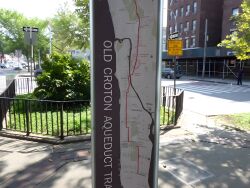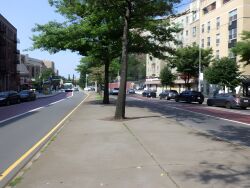University Malls
University Malls
University Malls are a series of traffic islands on University Avenue, which are named for New York University. NYU occupied the 50-acre University Heights campus located at 180th Street between Sedgwick and University Avenues from 1894 until 1973, when it sold the land to the City University of New York (CUNY) in an effort to mitigate financial difficulties. The Bronx Community College, which was founded in 1957, and joined CUNY when the City system was first established in 1961, now occupies the campus.
New York University was founded in 1831 when Latin and Greek were the focus of higher education. From its conception, however, NYU was progressive, offering modern languages and education in civil engineering, agriculture and other practical subjects. In 1832, NYU offered its first classes in rented rooms in four-story Clinton Hall, located near City Hall. The oldest of the university’s professional schools, the School of Law, was founded in 1835. NYU’s original name was University of the City of New York, but even from the beginning it was known as New York University; the name changed officially in 1896. Despite protests for a less expensive, more utilitarian structure consistent with the practical philosophy of the university, the first university building was constructed in the Gothic style in 1837.
NYU’s original move to the Bronx occurred in 1894. Chancellor Mitchell MacCracken, who is credited with turning NYU into a modern university, moved the bulk of its operations, along with the undergraduate College of the Arts and Sciences, University College, from Greenwich Village to University Heights. When NYU sold the University Heights Campus in 1973, University College merged with Washington Square College (founded 1914), which was the Arts and Sciences division of the University based in Greenwich Village.
The northwestern Bronx neighborhood of University Heights, originally known as Fordham Heights for Fordham Manor also takes its name from New York University. During the Revolutionary War, the British occupied New York and built forts in the neighborhood along the Harlem River. With the construction of the Jerome Avenue elevated line in 1918 and the Grand Concourse subway in 1933, apartment buildings went up quickly and property along University Avenue became sought-after real estate. Today, University Heights is one of the most popular areas for Vietnamese and Cambodian immigrants, and has a large black and Hispanic population.
Malls were first built in Italy and France, but soon spread to England. They were often used as playing fields for a game called pall-mall. The object of the game was to use a mallet to hit a wooden ball through an iron ring located at the other end of the green. The playing fields were long, narrow strips of grass, set off between streets. They were similar to bowling greens. Fences around the malls protected passers-by from stray balls.
Often located near the military quarters, malls were frequently used for parades. They also became popular as strolling promenades, and soon malls were being built for the enjoyment of pedestrians without accommodating sports. In the United States, malls diverged into two different forms: monumental pedestrian axes, and grassy or landscaped areas set between lanes of traffic. The Mall in Washington, D.C., which leads to the Capitol, is an example of the former and Mount Eden Malls of the latter. The street landscaping design slowly changed from pedestrian paths between lanes of quiet residential streets, but was retained as a landscaping technique after greater traffic volumes made these spaces inadequate for pedestrian usage.
The word “mall” is now most strongly associated with a third form: large enclosed shopping centers. Beginning as a hybrid between shopping arcades, which were popular in the 19th century, and the landscaped pedestrian promenades, the first enclosed shopping malls were usually oriented around a central walkway that included indoor trees, reminiscent of previous landscaped outdoor promenades.
New York City obtained the property for University Malls on April 20, 1897 and turned it over to Parks on April 29, 1936. A memorial flagpole for Bernard S. Deutsch (1883-1935), a local politician active in the Jewish community, was erected in 1937 by the American Jewish Conference. The Malls also feature decorative sidewalks, lampposts, and London planetrees (Platanus x acerifolia).
Check out your park's Vital Signs
Clean & Safe
Green & Resilient
Empowered & Engaged Users
Share your feedback or learn more about how this park is part of a
Vital Park System





